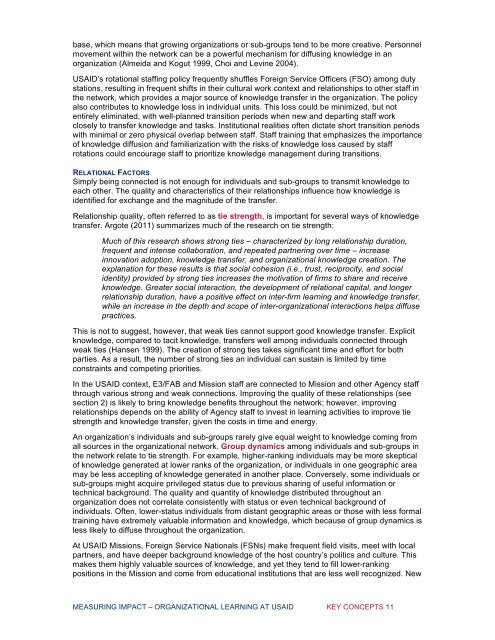MEASURING IMPACT Making Use of the Portfolio Organizational Learning at USAID
28Mzh2D
28Mzh2D
You also want an ePaper? Increase the reach of your titles
YUMPU automatically turns print PDFs into web optimized ePapers that Google loves.
ase, which means th<strong>at</strong> growing organiz<strong>at</strong>ions or sub-groups tend to be more cre<strong>at</strong>ive. Personnel<br />
movement within <strong>the</strong> network can be a powerful mechanism for diffusing knowledge in an<br />
organiz<strong>at</strong>ion (Almeida and Kogut 1999, Choi and Levine 2004).<br />
<strong>USAID</strong>’s rot<strong>at</strong>ional staffing policy frequently shuffles Foreign Service Officers (FSO) among duty<br />
st<strong>at</strong>ions, resulting in frequent shifts in <strong>the</strong>ir cultural work context and rel<strong>at</strong>ionships to o<strong>the</strong>r staff in<br />
<strong>the</strong> network, which provides a major source <strong>of</strong> knowledge transfer in <strong>the</strong> organiz<strong>at</strong>ion. The policy<br />
also contributes to knowledge loss in individual units. This loss could be minimized, but not<br />
entirely elimin<strong>at</strong>ed, with well-planned transition periods when new and departing staff work<br />
closely to transfer knowledge and tasks. Institutional realities <strong>of</strong>ten dict<strong>at</strong>e short transition periods<br />
with minimal or zero physical overlap between staff. Staff training th<strong>at</strong> emphasizes <strong>the</strong> importance<br />
<strong>of</strong> knowledge diffusion and familiariz<strong>at</strong>ion with <strong>the</strong> risks <strong>of</strong> knowledge loss caused by staff<br />
rot<strong>at</strong>ions could encourage staff to prioritize knowledge management during transitions.<br />
RELATIONAL FACTORS<br />
Simply being connected is not enough for individuals and sub-groups to transmit knowledge to<br />
each o<strong>the</strong>r. The quality and characteristics <strong>of</strong> <strong>the</strong>ir rel<strong>at</strong>ionships influence how knowledge is<br />
identified for exchange and <strong>the</strong> magnitude <strong>of</strong> <strong>the</strong> transfer.<br />
Rel<strong>at</strong>ionship quality, <strong>of</strong>ten referred to as tie strength, is important for several ways <strong>of</strong> knowledge<br />
transfer. Argote (2011) summarizes much <strong>of</strong> <strong>the</strong> research on tie strength:<br />
Much <strong>of</strong> this research shows strong ties – characterized by long rel<strong>at</strong>ionship dur<strong>at</strong>ion,<br />
frequent and intense collabor<strong>at</strong>ion, and repe<strong>at</strong>ed partnering over time – increase<br />
innov<strong>at</strong>ion adoption, knowledge transfer, and organiz<strong>at</strong>ional knowledge cre<strong>at</strong>ion. The<br />
explan<strong>at</strong>ion for <strong>the</strong>se results is th<strong>at</strong> social cohesion (i.e., trust, reciprocity, and social<br />
identity) provided by strong ties increases <strong>the</strong> motiv<strong>at</strong>ion <strong>of</strong> firms to share and receive<br />
knowledge. Gre<strong>at</strong>er social interaction, <strong>the</strong> development <strong>of</strong> rel<strong>at</strong>ional capital, and longer<br />
rel<strong>at</strong>ionship dur<strong>at</strong>ion, have a positive effect on inter-firm learning and knowledge transfer,<br />
while an increase in <strong>the</strong> depth and scope <strong>of</strong> inter-organiz<strong>at</strong>ional interactions helps diffuse<br />
practices.<br />
This is not to suggest, however, th<strong>at</strong> weak ties cannot support good knowledge transfer. Explicit<br />
knowledge, compared to tacit knowledge, transfers well among individuals connected through<br />
weak ties (Hansen 1999). The cre<strong>at</strong>ion <strong>of</strong> strong ties takes significant time and effort for both<br />
parties. As a result, <strong>the</strong> number <strong>of</strong> strong ties an individual can sustain is limited by time<br />
constraints and competing priorities.<br />
In <strong>the</strong> <strong>USAID</strong> context, E3/FAB and Mission staff are connected to Mission and o<strong>the</strong>r Agency staff<br />
through various strong and weak connections. Improving <strong>the</strong> quality <strong>of</strong> <strong>the</strong>se rel<strong>at</strong>ionships (see<br />
section 2) is likely to bring knowledge benefits throughout <strong>the</strong> network; however, improving<br />
rel<strong>at</strong>ionships depends on <strong>the</strong> ability <strong>of</strong> Agency staff to invest in learning activities to improve tie<br />
strength and knowledge transfer, given <strong>the</strong> costs in time and energy.<br />
An organiz<strong>at</strong>ion’s individuals and sub-groups rarely give equal weight to knowledge coming from<br />
all sources in <strong>the</strong> organiz<strong>at</strong>ional network. Group dynamics among individuals and sub-groups in<br />
<strong>the</strong> network rel<strong>at</strong>e to tie strength. For example, higher-ranking individuals may be more skeptical<br />
<strong>of</strong> knowledge gener<strong>at</strong>ed <strong>at</strong> lower ranks <strong>of</strong> <strong>the</strong> organiz<strong>at</strong>ion, or individuals in one geographic area<br />
may be less accepting <strong>of</strong> knowledge gener<strong>at</strong>ed in ano<strong>the</strong>r place. Conversely, some individuals or<br />
sub-groups might acquire privileged st<strong>at</strong>us due to previous sharing <strong>of</strong> useful inform<strong>at</strong>ion or<br />
technical background. The quality and quantity <strong>of</strong> knowledge distributed throughout an<br />
organiz<strong>at</strong>ion does not correl<strong>at</strong>e consistently with st<strong>at</strong>us or even technical background <strong>of</strong><br />
individuals. Often, lower-st<strong>at</strong>us individuals from distant geographic areas or those with less formal<br />
training have extremely valuable inform<strong>at</strong>ion and knowledge, which because <strong>of</strong> group dynamics is<br />
less likely to diffuse throughout <strong>the</strong> organiz<strong>at</strong>ion.<br />
At <strong>USAID</strong> Missions, Foreign Service N<strong>at</strong>ionals (FSNs) make frequent field visits, meet with local<br />
partners, and have deeper background knowledge <strong>of</strong> <strong>the</strong> host country’s politics and culture. This<br />
makes <strong>the</strong>m highly valuable sources <strong>of</strong> knowledge, and yet <strong>the</strong>y tend to fill lower-ranking<br />
positions in <strong>the</strong> Mission and come from educ<strong>at</strong>ional institutions th<strong>at</strong> are less well recognized. New<br />
<strong>MEASURING</strong> <strong>IMPACT</strong> – ORGANIZATIONAL LEARNING AT <strong>USAID</strong> KEY CONCEPTS 11


